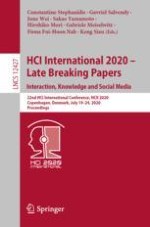2020 | Buch
HCI International 2020 – Late Breaking Papers: Interaction, Knowledge and Social Media
22nd HCI International Conference, HCII 2020, Copenhagen, Denmark, July 19–24, 2020, Proceedings
herausgegeben von: Prof. Constantine Stephanidis, Prof. Gavriel Salvendy, June Wei, Sakae Yamamoto, Hirohiko Mori, Dr. Gabriele Meiselwitz, Dr. Fiona Fui-Hoon Nah, Keng Siau
Verlag: Springer International Publishing
Buchreihe : Lecture Notes in Computer Science
